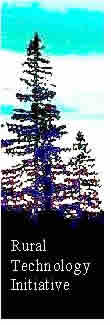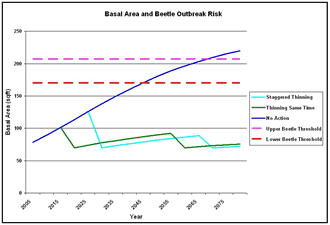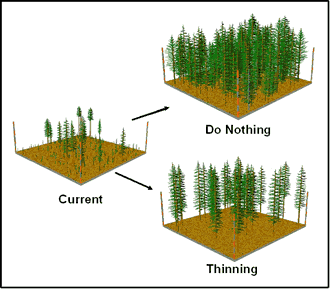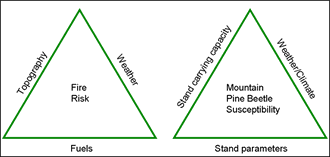 |
 |
 |
 |


Summer 2005, Volume 5, No. 3
Click here for a PDF copy of this Newsletter!Table of Content
|
|||||||||||||||||||||||||
|
The Economatic program within LMS was used to analyze cash
flows over time for each of our three management alternatives.
We also tracked basal area over time relative to risk thresholds
for fire and insects (Figure 1), and we created visualizations
showing the aesthetic outcomes of each alternative (Figure
2). These results demonstrate that carefully planned thinnings
can provide steady income, maintain forest health, and also
maintain aesthetics. |
The management alternatives
that we demonstrated will serve as a baseline from which
Sr. Carol Ann Wassmuth of St. Gertrude’s can begin
to explore the possibilities and uses of LMS and other technology
tools. Our next step is to hold a one day “workshop” for
the Sisters so they can better understand how these programs
can be utilized for developing sound economic and ecologic
management decisions. - Daisuke Sakuma and Brian Spradlin -
|
Developing Density Thresholds to manage Mountain Pine Beetle AttackEastern Washington forests are increasingly impacted by insect outbreaks that are thought to be beyond their historic range of variability. One of the more destructive insects in eastern Washington is the Mountain Pine Beetle (MPB) (Dendroctonus ponderosae Hopkins). According to the 2004 Department of Natural Resources aerial survey, this tiny insect is responsible for upwards of 430,000 acres of mortality in pine species out of the approximately 2.8 million acres of pine dominated forests found across the state. Typically the largest trees and those in more densely stocked forests are attacked and killed by MPB. These trees are often under moisture stress which predisposes them to MPB attack – but not all sites demonstrate the same degree of stress at the same stocking levels. In looking for ways to reduce MPB caused mortality, we need to combine knowledge of plant physiology, stand dynamics, climate, and site specific ecological metrics to determine when a forest is too dense relative to its site and thus vulnerable to MPB infestation. Only then can we determine optimal treatments and effectively design density reductions to maintain healthy forest conditions. There has been much research conducted on the processes related to outbreaks of MPB in the pine forests of western North America. At the stand level, studies have described the links between successful bark beetle attacks and stand parameters such as density, basal area, age, species composition, and crown competition. Risk rating systems have been developed using stand parameters, beetle population metrics, or some combination of the two to arrive at a broad, generalized categorization of risk, hazard, and |
susceptibility. The studies
have greatly advanced knowledge of how the MPB interacts
with its host tree, but not the underlying mechanisms that
result in equally high mortality under stand conditions that
are not similar. Researchers documenting MPB attacks have
found a range of threshold values after which stands become
susceptible. Those thresholds are based on stand parameters,
but stand parameters are only one side of the equation. One
linkage that requires more research in our efforts to understand
thresholds is the role of site carrying capacity, which typically
has not been incorporated into susceptibility assessments. |
Relationships between site carrying capacity and mortality from insect attack have been hinted at as early as 1987 when Fred Hall used data from Sartwell and Stevens 1975 work on bark beetles in the Black Hills as part of a site carrying capacity metric called Growth Basal Area or GBA. GBA is the basal area a stand can carry at 100 years of age and still maintain a growth rate of 1” per decade in radial increment on the dominant trees. GBA is a useful measure for assessing site carrying capacity relative to MPB attack because trees allocate photosynthate to survival and root and shoot growth first and only then to diameter growth and insect resistance in approximately equal ranking. Because of this equivalence in allocation, diameter growth provides a useable estimator for tree vigor and stand health relative to insect resistance. The question |
remains: How do we specify the links between a growth index
like GBA and the forest health benefits we might obtain from
managing stands to keep them within the carrying capacity
of the site? - Elaine Oneil, Ph.D. student in Silviculture
- |
Uneven-Age Management in Dry-Site Douglas-fir Stands at Ft Lewis, WashingtonIn the Westside forests of the Pacific Northwest, there is growing interest in uneven-aged management for ownerships with a mix of financial, wildlife habitat, aesthetic, and other objectives. Forest stands on Ft. Lewis, Washington are being managed for such a mix of objectives under an uneven-age silvicultural system that relies on natural regeneration. Under a partnership between Ft. Lewis, RTI, and the U.S.F.S. Pacific Northwest Research Station in Olympia, RTI graduate student Derek Churchill recently completed an assessment of uneven-aged management in dry-site Douglas-fir stands at Ft. Lewis. Approximately 25% of the forestland (15,000 ac) at Ft. Lewis
is dry-site Douglas-fir forest that established over the last
150 years on former prairies with coarse textured, droughty
outwash soils. These stands have been managed for the past
several decades with light thinning entries that remove 15-20%
of standing volume at roughly 10-year intervals. In the understory,
Douglas-fir is well established and is the only conifer species
present. Ft. Lewis managers are relying on this naturally regenerated
Douglas-fir to become overstory trees in the future as they
continue the 10-year cycle of thinning entries. Managers wanted
to assess the vigor of the existing Douglas-fir regeneration
to determine whether it is a viable source of replacement trees
and what management strategies are needed to ensure that the
current silvicultural system is sustainable. |
were investigated in thirteen stands at both the individual tree and stand levels. Indices of understory vigor (live crown ratio, height-to-diameter ratio, and crown density) were combined to produce two methods of quantifying vigor: a regression model that predicts volume growth as a percent of maximum site potential (relative volume growth) and a simple 4 class vigor classification system. The management implications of different levels of vigor were then defined by linking each of the 4 vigor classes with estimates of release potential and the likelihood of recruitment into the overstory without further release. At the individual tree level, a strong relationship was
observed between the relative volume growth vigor metric,
overstory density, and competition from neighboring understory
trees and shrubs. Regeneration with low levels of understory
competition was shown to require an average of >35% full
sunlight (<25% full site occupancy) to achieve levels
of vigor where recruitment into the overstory without further
thinning begins to be possible. If released, these high vigor
trees will quickly attain growth rates comparable with trees
that were never suppressed. Between 15-35% full sunlight
(25-55% full site occupancy), regeneration was found to be
growing too slowly to recruit into the overstory without
release. However, understory trees did appear to have sufficient
live crown and stem stability to be able to adequately respond
to release. Below 15% full sunlight (>55% full site occupancy),
regeneration was scarce and of poor vigor. For all vigor
classes, regeneration with high levels of understory competition
was found to require more light to achieve the same growth
rates, and this effect increased in higher light environments. |
| A
stand level model was also developed and demonstrated that
while overstory density is the dominant factor influencing
understory vigor, understory stocking, shrub cover, and the
spatial arrangement of the cohorts are also important. Guidelines
were developed for managing both the overstory and understory
to help managers achieve the desired balance of stand volume
growth, structural and habitat goals, and understory vigor.
While maintaining the overstory below 25% full site occupancy is necessary to recruit Douglas-fir advanced regeneration into the overstory, entire stands do not need to be thinned to these low levels. Rather, to balance the tradeoff between total stand volume growth and vigor of regeneration, patchy stands can be created in which some areas are treated with light thinnings from below to maximize volume growth, other areas are thinned more intensively to establish |
regeneration and maintain its release potential, and other areas are opened up to provide enough light for regeneration to grow vigorously and recruit into the overstory. In this last case, group selection and clumped retention, rather than more uniform heavy thinnings, appear to use growing space more efficiently. In addition to overstory thinning, pre-commercial thinning and shrub control around crop trees where regeneration is clumped in thickets or dense throughout a stand has the potential to significantly increase vigor levels, especially in more open stands. This study suggests that uneven-age management is ecologically possible with Douglas-fir on dry sites using a mix of single tree and group selection systems and can yield both market and non-market benefits. -By Derek Churchill, MS in Silviculture- |
Economic, Social and Silvicultural Analysis of Converting Residual Forest Biomass to MethanolThe sustainable management of western forests is becoming increasingly difficult in the face of intense summer forest fires, large insect outbreaks, and limited silvicultural options due to the loss of markets for lower quality, small diameter wood. The ability to utilize low-quality, small-diameter wood has diminished over the past two decades as a direct result of the closure of pulp and saw mills throughout the region. Frequently blame is laid for these closures on the increased regulatory environment associated with wildlife habitat protection policies and the subsequent loss of a steady supply of raw material. Other researchers claim that the phenomenon of western mill closures is a function of a glut of raw material available both domestically and abroad. This research has changed the focus from finding a cause for this shift in demand for western wood products to finding alternative uses for these resources. It is looking at integrating small-scale, mobile wood biomass chemical conversion to liquid fuel (methanol) systems with emerging technologies in the renewable-energy sector (hydrogen fuel cells). |
The economic feasibility has traditionally not favored such
chemical conversion systems, but the combination of technology
improvements for the conversion processes and policy shifts
associated with green credit markets and other incentive
based programs can shift the market dynamics in favor of
such a system. Such a system would potentially provide a
needed economic boost to rural economies once dependent on
timber revenues by providing jobs in the logging sector,
as well as in the production of wood-based methanol. Such
a system would likely not be subject to the market fluctuations
associated with excess raw material on the market, because
the harvested wood would be coming from silvicultural operations
normally considered pre-commercial. The added value is both
in the production of energy from a negatively valued product
as well as a silvicultural option that promotes a fire safe
and vigorous forest. - By Michael G. Andreu, Ph.D. in
Silviculture - For additional information on this study please visit http://www.cfr.washington.edu/research.Forest_Energy/ |
Upcoming Events |
 |
|
| July
9, 2005
Thinning for forest health workshop Tolt River Highlands, Carnation, WA For information contact Amy Grotta, WSU King County Extension, at (206) 205-3132 or amy.grotta@metrokc.gov July 16, 2005 August 13, 2005 September 14-16, 2005 September 24, 2005 (tentative) Oct-Nov, 2005 December 4-6, 2005 |
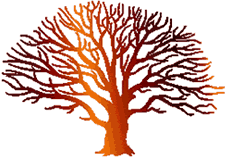 |
|
Readers may send comments to:Editor, RTI News |

